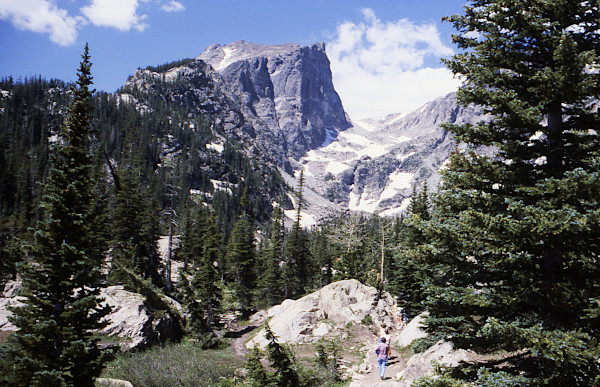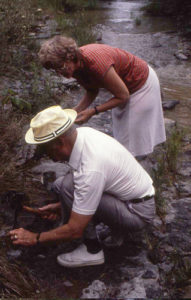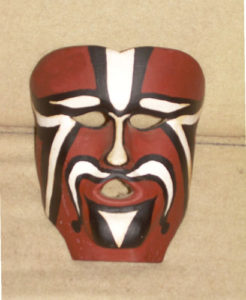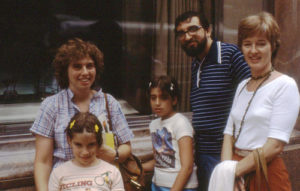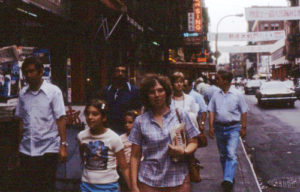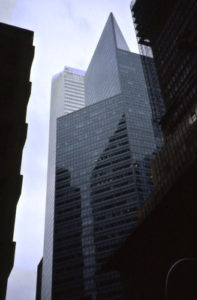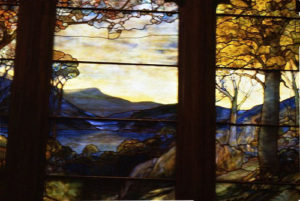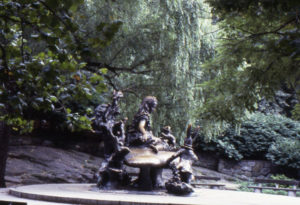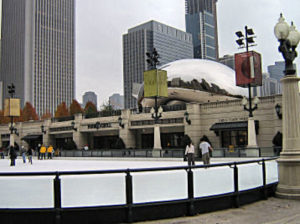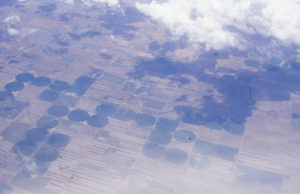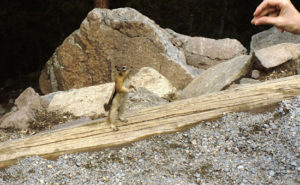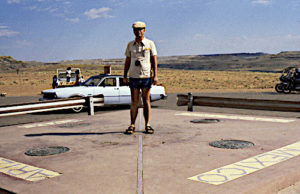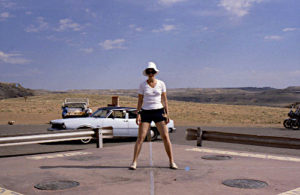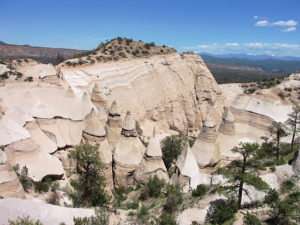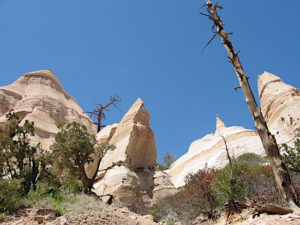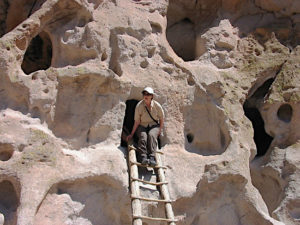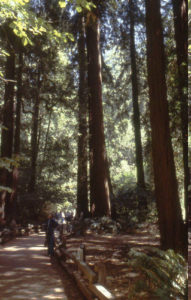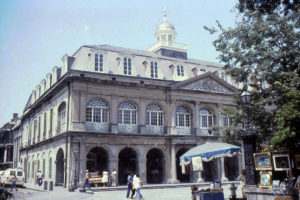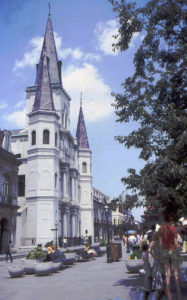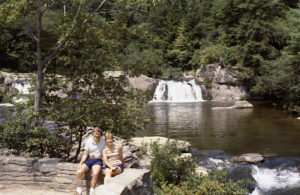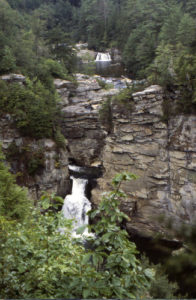Click on photos for larger versions.
I have already talked about many memorable events and friends from our thirteen years in Paris. There are also, however, a few other trips not to be forgotten, undertaken during those thirteen years. I will get back to the high points in later travels in another chapter.
We of course went to the United States quite often, Orlando in particular, to see John’s parents and family in Florida, and also, later on, in Daytona Beach where John’s sister Marjie and husband Joe lived for some decades. I got to know John’s wonderful grandmother already on our first visit together to Orlando for Christmas 1971 when John came over from Paris. Sister Marjie’s daughter Neall was not yet one year old.
In 1985 we even traveled with Margaret and Bert from Ohio, where they both originated from, and where we went fossil hunting with Bert, a thing Bert loved to do and that he had done many times with John before this.
We met quite a few of Margaret’s family and, big surprise for me at least, we saw a lot of Amish country people and horse carts. I had always thought that the Pennsylvania Dutch country was the Amish country, but I now know that there is quite a substantial Amish community in Ohio as well. Fascinating seeing these people who live almost as if it were the 19th century, or even before that.
And, by the way,’Dutch’ country is clearly a linguistic goof. The settlers in that region were not Dutch, they were German, Deutsch. I realized that one time in the mid-sixties when Allyn and I went down the Delaware river, shooting the rapids, which were not very rapid that spring. We pulled the canoe up onto the shore once and went to have Tom Collins at a bar on the Pennsylvania side of the river. It is just the right drink on a warm summer day. I saw all kinds of textile and wood decorations on the walls and they were all in German. I didn’t know Dutch, but I did know German. It was such an easily understandable mistake. – Where do you come from? – I am deutsch. – Oh you are Dutch. – Yes yes, I am deutsch.
I don’t remember if the owners of the bar spoke German, but it was a truly German style bar. I am sure that they knew what the writings on the wall were saying though. I talked with the owner about how it was German and not at all Dutch.
In 1985, we visited quite a few remarkable historical sites in Ohio, like the Serpent Mound that nobody has been able to establish the origin of. John and I walked through the spectacular caves, Hocking Hills, well worth it, and we also visited Gnadehutten with a more ominous history.1. From Ohio we traveled south through Kentucky horse breeding land, North and South Carolina, Virginia and Georgia. That was a few years after our big tour of the United States in 1979, and we then got to know some very interesting places that we had to skip in ’79.
During our thirteen years in Paris, we also went to Sweden quite a few times and some very special events stand out more than others. I have already mentioned at some length our memorable trip to Bergslagen (= the law of the mountains, it used to be an important mining area) west of Stockholm and what we call middle Sweden. (Chapter 21 (Part 2). That time, in 1984, we traveled with old French friends Jean and Danièle, their son Olivier and a son of other close friends; François. I have also talked about our travels to Stockholm on several occasions. There are a few very different trips that must not be forgotten here though, not to Sweden and not to Ohio.
__________________
In 1979 we made our big trip through the U.S, my first visit to most of those places, including Chicago for both of us. We have been back was much later to visit our very good friends John and Penny in their luxury apartment — big windows overlooking Lake Michigan — and we were co-invited with our very dear old friends Mossy and Sandy from San Diego, California. A wonderful visit where we managed to go to both the Art Institute of Chicago and the Field Museum of Natural History. To see more of this amazing visit to our friends and to Chicago, go to Chicago November 14 – 17, 2006 , our travel site. It was a true reunion since Mossy, John and John had been close friends ever since junior high school. John and John (the other John in my John’s family parlance) both played clarinet in the school band together.
Our 1979 tour was one long and fabulously eventful trip through the U.S., including many high points in terms of beauty and archaeological interest.
During our thirteen years in Paris we had visited with Girv and Pam several times and they also came over to Paris to see us twice. This time, in 1979, like many other times, our good old friend Girv — who was my colleague from Mamaroneck High School — picked us up at Kennedy Airport, which is one long trip from where he and his wife Pam live in Putnam County, north of Westchester County. A few years later he, very understandably got tired of that long drive and we managed, once at least, to fly in to an airport much closer to where he lived. It might have been Westchester County Airport — not sure. We also once arrived by train in Carmel, the closest city to where he lived. Girv had retired early as a special education teacher, and an exceptionally good one at that.
The reasons for his early retirement were many — partly he got tired of dressing in suits but I think that what mainly irked him was the very long twice daily drive from close to Carmel, in Putnam Co. to Mamaroneck in Westchester Co. Also, and not least, one of Girv’s passions in life was woodcarving and his basement was so full of wood-shavings that it was difficult to walk across to his wood-carving bench. He made furniture that sold at a substantial price and his art was exhibited at a gallery close by that he took us to see once. He once made an entire set of dinner table and chairs for a wealthy Westchester family. I hope he made them pay heavily for his handmade furniture.
Another passion in Girv’s life was growing vegetables and flowers. He claimed that lilies of the valley (muguets) spread like weeds, and they did at his place. There were masses of them next to his little meditation house, which he had built himself of course. However, we have never managed to get muguets (as we call them) to grow here. The same with dill by the way. So now we buy fresh dill and freeze some for the cold season. Girv is a long story, and there is no way I can describe this exceptionally good and talented man. He became a very good friend of John’s too.
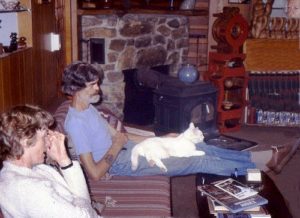
Girv sittingg the way we often saw him sit, with Magicat on his lap. Siv is seen in a blurred way in the foreground.
And oh, Girv’s real passion was his cats, one at a time. The first one we knew and his name was Magicat, and he was a magnificent white cat who had simply wandered in one day and adopted Girv. Magicat came when Girv whistled, which is quite unusual for a cat. There was great mutual love between the two men.
When Magicat died of old age, Girv did what everyboy should do when they mourn a lost animal — find another one. So Girv got a new cat. Well, he somehow found another cat who was black, I believe. He wrote to us and told us that the only name he could find now after ‘Magicat’ was, he said, Magnificat. That was very very funny, but I doubt if he really called him by that name. Anyway, Girv whistled, he didn’t call his cats, the way we do.
Pam was a strange woman, an aging hippy and I never saw her in any clothes that were not hippy-like. She insisted on their names being Girvan and Pamela, which John and I didn’t care a bit for. She had first been married to what she always called a ‘Persian’ businessman,
in the days of the shah. One funny thing John and I both remember was a wonderful lamb stew she once made after a ‘Persian’ recipe. When they later on became vegetarians, we reminded her of this succulent stew and she had forgotten all about it. We also have a wonderful chicken recipe that I make and that we still today call Pam’s chicken, with lots of tarragon and lemon cooked in a ‘cocotte‘, served with rice and a sauce that gets to be heavenly from all the tarragon and lemon.
When Girv, who was very much my senior, died a couple of years ago, his daughter Betsy wanted us to have one of his very colorful carved and painted masks, more like native American masks than the African kind that our friend Jean has several of.
__________________
After a couple of days with Girv and Pam, we moved on to New York City by train from Carmel, more precisely, to Brooklyn. We spent another couple of days with my dear friend Norma, also a former colleague of mine and a Latin teacher at Mount Vernon High School, and her husband Ted, a chemist. One afternoon we went to Chinatown to have dinner with friends Bella, French teacher at Mount Vernon High School, husband Roy and very young daughter Laura. We have seen Laura much later here in Genas with her now husband Paul, who was at that time working on a doctoral dissertation on ‘Das Lied von der Erde’ by Mahler, one of our favorite composers.
Norma and daughters came and see us in Paris for a week or so in 1981. Linda sprained her ankle in a playground down towards les boulevards extérieurs and she was delighted to come back from that adventure with a cast on her right leg, which we all signed with magic markers.
I can’t think we went to a show with Ted and Norma in ’79, but I do remember the interminable ride in the subway back to Brooklyn. And the subway trains were really rugged looking at the time. They at least have been immensely improved since then. U.S. infrastructure is falling apart but the NYC subway system seems to be doing well.
It was on a later visit to New York City, in 1989, that I was first staying with Norma in Brooklyn and after that wonderful Norma drove me all the way to Appleton, New Jersey, where I spent a couple of days with another dear friend and also a former colleague. This was Annie from l’Ecole Centrale de Paris, and her French husband Louis-Henri whom I also knew very well from Paris. They had decided to move to the United States, move back in Annie’s case, and they are now living in Pennsylvania, Their two sons flew out a long time ago and one of them lives and works in Germany as a neurosurgeon.
That time, in 1989, John was at a meeting at Brookhaven National Laboratory on Long Island, where he had worked for 2 years as a post-doc before leaving for France. When we met up in New York City, I remember very well (and so does John) that we went to Nyborg and Nelson for lunch and had Swedish gravad lax with — what else? snaps of course. Nyborg and Nelson, a store selling Swedish food products used to be in a rather unassuming location in midtown 2nd Avenue with an equally unassuming restaurant on the first floor above the store.
It had now moved to the posh Citicorp Center building on Lexington Avenue and 53rd Street. It was a happy reunion for John and me after the few days apart. And what a very Swedish celebration.
We did not stay many days in the City that time, but I do remember saying I wanted to put my feet on 6th Avenue to really get the feel of having been to New York City. There is nothing more ‘modern New York City’ than 6th Avenue. And I will never forget how they were restoring that entire area, rebuilding the street above the subway. For years in the sixties you drove on loudly rattling and enormously heavy wooden boards or metal slabs while the street got remade and all the new glass skyscrapers were growing up. We got the new look of 6th Avenue in the late sixties. It was indeed a complete renewal of the whole area.
We may not have been staying very long, but I see from the pictures we took that we did an amazing lot of things. We walked around in the streets, we made a visit to the Metropolitan Museum, where we visited the American and Egyptian wings, and to the Guggenheim as well. We walked around in Central Park more than we had ever done before. We saw the statue of Hans Christian Andersen with the ugly duckling at his feet and also Alice in Wonderland with the March Hare and the Mad Hatter. We were tourists this time. When we walked around with our niece Kajsa in early summer 1973, we were residents.
I had fallen in love with Central Park on my very first visit alone to New York City in the fall of 1964 when I took the New Haven railroad to Grand Central Station and the subway uptown to Hunter College on Lexington Avenue.
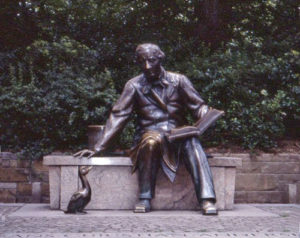
Here is the wonderful but gory story teller himself, Hans Christian Andersen, famous all over the western world.
I was there to enroll in a graduate class on “The History of the English Language” at Hunter College, located between Lexington Avenue and Park, on 68th Street. It was a course that was required for a higher grade (20 more points) at Lund University along with “American literature” which I took at Westchester Community College.
The thing was — I could not be sure that I was going to stay and live in the U.S., and so I was hedging my bet. I of course never went back to Lund University to pass the exam that would be like getting 60 points in my Master’s degree rather than the 40 points I already had. However, both these courses turned out to be very useful for me, especially for my future role as an English teacher in France, which of course was a thing I could never have imagined at the time. I actually taught theme classes on “American literature and civilization” for several years, after those had been introduced at l’Ecole Centrale de Paris. Those were of course for the top-level students.
The stop where you get off the Lexington Avenue Line is 68th Street–Hunter College, and you are right at the back entrance to Hunter College, where certainly most of the students enter this prestigious university. Wonderfully handy and straight from Grand Central Station.
During the lunch break I crossed over from Lexington, crossed over Park and Madison, and on to 5th Avenue. I walked into Central Park and I could hardly believe my eyes. What a paradise. Rocks and lakes and everything so much like wilderness and at the same time well cared for. Young people were sitting on the rocks and a lot of guys were playing football of some kind. This is a true oasis in the big city where pollution is constant and it’s a place for ball playing, jogging, biking or just walking around.
______________ __
From New York City we flew to Chicago and this was our very first visit to that wonderful city. Even after a second and longer visit in 2006 to stay with our dear friends John and Penny in their wonderful apartment I still don’t feel that I know the city even halfway. At the same time our old friends from San Diego, Mossy and Sandy whom I had known since 1971 were staying in a second guest suite. Talk about luxury!
That visit has now almost eclipsed our first trip to this remarkable city on the lake, but I do remember a lot of wandering around the most outstanding sites and a very thorough visit of the Art Institute of Chicago, which was of course repeated in 2006. Even this first visit was an event of sheer pleasure. This museum must be one of the topmost art museums in the world. You could probably spend a day there and still not see everything. As usual, though, John and I spent about an hour walking around the museum, then lunch in the excellent museum cafeteria and then another hour or so of more walking around.
Also, most importantly, we went to a jazz cub close to where the van Horns now live to hear Art Blakey and his band the Jazz Messengers with the Russian trumpet player Valery Ponomarev.
We were young at the time and we walked all around the most interesting monuments,
plazas and outdoor sculptures and art. I was particularly impressed by Chagall’s wall of stained glass art on a background of blue in the museum, which was close to the beginning of our tour. It was a great opening sight to this huge city with so many things to see.
We were staying at the Holiday Inn, and all I can remember from the hotel was how thoroughly bad their morning coffee was. I have never had worse.
The city has changed enormously, and very much for the better. The Millennium Park is now the foremost place to see for tourists as well as for the natives, with the skating rink, the ‘post-modern’ Cloud Gate sculpture, dubbed “the Bean” by Chicagoans because of its shape. in the background there is the extraordinarily modern architecture of the Jay Pritzker Pavilion and the green park. (Chicago November 14 – 17, 2006) The Millennium Park was originally intended to celebrate the third millennium, but as it happened it was only opened in in July, 2004.
Also, we did not see the beautiful old buildings (maisons classées) on the lakeside where John’s and Penny’s building is located on Lake Shore Drive. At the time they lived in an eastern suburb of Chicago, and we only got back in touch later on when the had moved to Lyon.
________________
From Chicago we flew on to Denver, Colorado where we were to see some of the most spectacular lake and mountain scenery. We flew over the agricultural states of South Dakota and Nebraska and it was odd to see from up above the circular irrigated fields looking like a drawing board. We were not sorry that we only got to know this part of the Midwest from the air.
Once in Denver we drove north to Estes Park and the mountainous areas where we were going to do some of our first mountain hiking together. I had done mountain hiking two summers in Lapland with my family when I was very young, but John and I had not, before this, even considered mountain hiking. And even less mountain climbing. We were to find out a lot about that in Vorarlberg in the Austrian Alps from 1980 and on for twenty years.
This young man from Florida was going to become a better climber than I was. But first I had to teach him about ‘lunking‘ (Swedish ‘lunka‘), i.e. walking steadily but not too fast so that you can keep up the steady speed you settle for.
It was a short drive to Estes Park and we spent two nights at a hotel so that we could discover the beauty of the Rocky Mountains National Park and its gorgeous lakes. Our goal was Emerald Lake that is situated right below the very impressive mountain Hallett Peak, 3,875 meters high.
The hike was easy, even though guidebooks say that the last two hundred meters are quite steep. All the lakes were beauties and of course Emerald Lake is the jewel in the Rocky Mountains National Park.
____________________
The next day we drove across the Rocky Mountains, up on what was for me at least a very unexpected Alpine tundra – lots of various tiny flowers and you were not allowed to step off the road, so we did not. Of course we got out of the car to admire this tundra, a kind of scenery that we have never seen in the Alps in later years, even though it is called Alpine tundra. We are more used to Alpine luscious green hillsides and meadows with globe flowers and high daisies, bluebells and various kinds of corn flowers, and of course buttercups, in masses. Also what is called Alpenrosen, which is wild azalea. More about that later in another chapter.
We drove down into Utah where we were heading for the amazing Arches National Park and I was going to walk in desert sand for the first time in my life, not as burning hot as in many places in India though — that too being a later story.
Wikipedia explains how 300 million years ago there was a sea in this large area. The sea evaporated and left this enormously thick underground salt bed, which is the cause of these fantastic rock formations. 2
From the Arches National Park and my very first experience of desert sand, we traveled back east to Colorado, but this time close to the very southeastern corner of the state. We were about to see Mesa Verde. These cliff dwellings are some of the most fascinating archaeological sites I have ever seen. A mesa is a flat-topped mountain formation that is found in various places in the southwestern region of the United States. We have seen quite a few incredibly beautiful sites in Greece and Turkey, some quite unique, but Mesa Verde was something very different in many respects..
Mesa Verde National Park is huge and and includes 600 cliff dwellings. We only saw the southern part which includes both Spruce Tree Terrace and Cliff House, two of the most spectacular cliff houses.
We saw two pueblos, Cliff Palace which is the largest of all the pueblos at Mesa Verde. It contains 150 rooms and 23 ‘kivas’, round sunken rooms most likely used for ceremonial purposes. It is supposed to have had about a hundred inhabitants and it was the largest cliff dwelling in North America.
Spruce Tree House is the third largest cliff dwelling and it was equally spectacular. It contains 130 rooms and also fewer kivas. This best preserved site has been closed to the public since 2015 after a rock fall and a following close evaluation by park officials.3
Mesa Verde National Park is a UNESCO World Heritage Site. It was inhabited by the ancient Pueblo people known as the Anasazi, who made these stone villages their home for 700 years, from 600 AD to 1300 AD. They are supposed to have left the villages because of a long drought period which destroyed their agricultural livelihood on top of the mesas. Mesa Verde is the most ancient archeological site in the United States.
What blows my mind when I go to all these wonderful places is the feeling that I travel back in time. I imagine how people actually lived here, worked here, made love and lived a family life, so entirely different from the way we live today. Those were not the days when families broke up the way they do now, even though in my personal little world families do stay together. Every member of the family and the tribe had his and her function. The old people took care of the children and the cooking. Maybe even some sweeping was done. And everybody got up with the sun and went to sleep when the sun set.
I can’t imagine what the Sami people up in the north did when there was no daylight during the long winter. Today they live in cities and towns in the agricultural areas in the winter. It is in the summer that they follow the reindeer, or at least they did when I was an adolescent and met and knew some of them. I and my family knew a Sami village up in the mountains around Stora Lulevatten and the entire families were up in the very west of Lapland during the summer. But I also know that this specific village was burned down soon after we had been there in 1950, by some pyromaniac, it was said.
Back to Mesa Verde. Since it is called ‘mesa verde’, it makes it obvious that the top of the mountain, the ‘mesa’, was fertile land. It is considered a fact that the tribes left the pueblos because of long-lasting drought.
On our way westward, to Monument Valley, which is situated right on the border between Utah and Arizona, we of course stopped at Four Corners to stand with each foot in two states at the same time, the four states being New Mexico, Arizona. Utah and Colorado.
From Monument Valley, we were going on to the Grand Canyon a bit farther down in Arizona.
This had been a truly meandering tour of the desert-like southwest of the United States.
We missed Bryce Canyon in southern Utah because of a little accident in the Grand Canyon National Park. John stepped off the path.
___________________
In a parenthesis, we went hiking in New Mexico many years later. It was in 2004, when I came along with John and Philippe, a colleague of John’s and and a friend of ours, to Santa Fe in New Mexico. There was a meeting for Computer people and whenever i could I usually came along with John to these international meetings.
We got to see the city and the spectacular region around it. We spent two days climbing and hiking in these spectacular rocks and mountains with Philippe, the ‘alpiniste‘. Some of the rock formations in that area are almost unbelievable. Kasha-Katuwe Tent Rocks national monument impressed me the most. Kasha-Katuwe means “white cliffs” in the Keresan language Those cliffs are made of volcanic tuff, from volcanoes that erupted around a million years ago.
We have in fact, many years later, seen some rock formations a bit similar in Cappadocia, central Turkey, composed of the same tuff. But this was a first. The second day we visited the Bandelier national monument and climbed into the caves behind the cliff wall, on a ladder that was supplied by the park authorities. .
Quote from New Mexico’s top 10 national and state parks:
“Around a million years ago, the Valles Caldera supervolcano in the Jemez mountains exploded, blanketing the region with ash more than 1,000 feet thick. Over time, this ash layer solidified into a soft, easily eroded, whitish rock called tuff. At Bandelier national monument, tucked deep inside Frijoles Canyon, ancient Puebloan people used hand tools to shape natural caves in the tuff into shelters known as cavates.
Here they lived for hundreds of years, raising turkeys and cultivating corn, squash. They eventually dispersed throughout the south-west after a prolonged drought.”
I remember well that I had, stupidly, completely forgotten to bring hiking clothes. So the first day we stopped at a men’s clothing store and got me a pair of men’s pants and I wore one of John’s shirts, judging from what I see in the pictures we took.
It was 2004 and we both had digital cameras now, so I could take my own pictures with my own camera. John had always been a photo freak with a fancy Pentax camera, but I had made do with a Kodak I bought when I took a year’s sabbatical leave from Mamaroneck High School in 1970. I spent a year teaching English in Paris, actually at Université de Paris sud in Orsay. That was after Allyn and I had separated. So when John and I started traveling together in ’71, the spring when we first met, I always had my Kodak. I remember vividly how we compared the different colors of Kodachrome and Ektachrome film, one being bluer than the other.
All my pictures from Paris in 1970-71 I took with that camera. I had followed the advice of my friend Bo from Mount Vernon High School. I went to the library to look up medium-priced cameras in the Consumer Union magazine. I found that Kodak was the favorite and I actually bought it at Macy’s. Does it sound unbelievable that I didn’t even go to a camera store? Well, Macy’s was very handy, right there in New Rochelle, and I was neither rich nor a snob. (See ‘Visit to New Mexico in early May 2004‘)
___________________
Back to 1979 and our most remarkable tour of the United States. From Four Corners we drove west to Monument Valley in Navajo country. I don’t know why we don’t have more pictures, since I remember this National Park as being quite spectacular.
Then came the Grand Canyon. We drove southwest from Monument Valley and arrived at the Grand Canyon National Park that is famous throughout the world. I do believe I knew about the Grand Canyon even before I started studying English when I was 12. (In Sweden children now begin studying English at the age of 8, but in my days we were 12.)
The scenery was spectacular, but of course that is an understatement. We had seen canyons in France – gorges – but this was indeed worth its reputation for being grand. We walked around and took pictures, even though for some reason the colors came out very wrong. At the very end, John stepped off the asphalted path and — sprained his ankle. So. – Emergency station and a cast and crutches for my poor John. We now had to change our travel plans, skipping Bryce Canyon in southern Utah that we had planned to go to. Bryce Canyon, in spite of its name, is not a canyon, but it is definitely worth visiting. So there we are.
We made a call to Mossy and Sandy, our oldest and dearest American friends, asking if we could come right away to San Diego. It was OK and we were to fly out of Las Vegas to San Diego right away. Notice – this was before 9/11 and all the hysteria and fuss with security checks and this and that. Traveling by plane was easy and uncomplicated back in those days.
Now I was the driver in an old pile of garbage (says John), an automatic which I had never driven before. (Even Allyn had a stick-shift car, which I drove once a week on Hutchinson Parkway to White Plains, or more exactly to Valhalla for my American literature classes at the junior college. I thought Allyn’s compact car was huge — at least on the narrow Hutchinson lanes.). However, the only one little problem was the power brakes, which I also was not used to. When I had to stop somewhere at an intersection I put on the brakes, and wow, did it stop! The man behind me yelled at me, but he managed to avoid running into us anyway.
____________________
Well, we saw all that we would ever see of Las Vegas — and more than we ever wanted to see. The next day we arrived at San Diego airport where Mossy picked us up and drove us to Solana Beach, a northern suburb of the city where they lived at the time.
Oh friends. We spent several days with Mossy and Sandy and their children who had grown considerably since we last saw them in the Philadelphia area. We picnicked, we visited San Diego of course, went to Bilboa Park where we admired a magnificent Henry Moore sculpture. We looked out over La Jolla beach, right north of San Diego, where Mrs Young, Mossy’s mother, had told us she learned to swim.
We spent a day in northern Mexico, driving straight through Tijuana, a tourist trap, and then continuing to Ensenada (a somewhat more genteel tourist trap) where we did a tiny bit of shopping and had lunch with real Mexican food, which I am not a particular friend of. But John certainly enjoyed it. Both Mossy and Sandy love spicy Mexican food and we have certainly had it with them in Florida as well. Mossy is John’s oldest friend from long-not-forgotten school days in Orlando, Florida. And even I knew his mother Mrs Young, a remarkable woman, who had invited us to her swimming pool and to Christmas parties when Mr Young, Mossy’s stepfather, was still alive.
John left his crutches with Mossy and Sandy, and they tell us they came to good use on at least one other occasion. So, after this milestone visit, really the high point of the entire tour, because of Mossy’s and John’s very special friendship from elementary school and on, John was now the driver again. We traveled north on the scenic road, California State Route 1. In a car that was less of a wreck this time. The road follows the coast and we did not miss Big Sur, Point Lobos and other outstanding places.
This was the tour of the USA of our lives, even though we did go back both to San Diego and also to San Francisco. And, not to be forgotten, we went to Santa Fe in 2004 and Chicago in 2006.4 And that is not counting all our visits to Florida, mostly Orlando, with side-trips all around the coasts, east south and west.
Traveling westwards from Orlando was mainly to see my dear uncle Ossian and wife Emma-Lena and several of my cousins and their children who live around Tampa. We visited them several times, but we were not up to joining them for Ossian’s 100th birthday party in 2006. I still made my little contribution by writing about Ossian’s life, including photos starting with my grandparents — photos most likely taken on the occasion of their engagement. I bound the pages as best I could, making a couple of copies and sending them by snail mail. Cousin Leif’s daughter Mona assured me that the “booklet” was on the table in their living room and that it would still be there on my next visit. Ossian lived to be 104, but, alas, we made no further visits to Tampa. I have still been in touch with Mona and Leif’s widow Christina.
California became part of the United States as late as 1848, after the Mexican–American War. So no wonder that most of the local names are religious names, such as Los Angeles and San Francisco. In fact, it should be remembered that most of the entire area in the southwest that we had been traveling through was part of Mexico before that war — including Utah and Colorado. The United States did pay a handsome price to Mexico for its secession of this huge area, but Mexico was clearly the loser at the end of that war.
Back to California Route 1 – the scenery was magnificent and I can only try to render the beauty of this scenic route through our pictures, which John scanned from slides a long time ago and organized in albums – with brief captions at that.
Among all the fun and interesting sites we passed by on our way to San Francisco, Point Lobos was an event for us to see. We had never seen sea-lions before. It was amazing how they seemed to actually cover the rocks off the Point Lobos coastline. Then we visited the mission San Carlos Borromeo, interesting because it reminded us so clearly of the past history of this region, being formerly Mexican as well as very Catholic. And the bougainvillea was magnificent, as our friend Girv had told us. Big Sur was very impressive as it loomed over route 1, and it was just about the only mountain we saw in California. I know though that people go skiing in the Sierras, mountains further inland. My former colleague and friend who liked to be called by her last name, Kelly, told me about skiing in the Sierras.
But the real event on that day was Monterey and Cannery Row. I loved seeing 800 Cannery Row, which was the address of Doc’s house in Steinbeck’s wonderfully funny book, “Cannery Row”. I was reminded of the hilarious stories in the novel about how Mack and the boys were repeatedly trying to do Doc favors – collecting frogs for Doc’s experiments and such anecdotes – and how something always went wrong. Mack and the boys, I think, are even funnier than Danny and his gang in Tortilla Flat, which is another a very funny novel by Steinbeck, an earlier one, but it is also set in Monterey.
How sad that Cannery Row, the way we saw it and the way John Steinbeck described it, is no more. The old houses have now given way to modern buildings, and only the Cannery building itself still exists, only in a very nice red color, not blue the way it was in 1979.
The day we were walking around Cannery Row and reliving Steinbeck’s novel was John’s birthday, 8/08. We found a restaurant right on the edge of the waterfront and we had a Reuben sandwich there — one of our favorite lunches in the U.S. It consists mainly of corned beef and sauerkraut with a dressing, between two slices of rye bread.
We had our favorite restaurants for Reuben sandwiches in New York City, where it was Carnegie Delicatessen on 7th Avenue and 55th street, famous for its Kosher food, and also in Orlando where it was Ronnie’s, a Jewish delicatessen restaurant and a landmark that, sadly, closed in 1995.
Carnegie Delicatessen closed its doors at the end of 2016, but John and I had some very special meals there — the best ever Reuben sandwiches followed by the most extraordinary cheesecake. You just don’t get real American cheesecake outside of the U.S.
The Carnegie Delicatessen clearly got its name because of its proximity to Carnegie Hall, which is one block away, also on 7th Avenue.
_______________
And so we get to San Francisco, the fabled city that I always wanted to get to know.
We walked around downtown and enjoyed seeing the typical San Francisco townhouses, low houses in pastel colors, where you get the impression that the past American way of life has not quite been taken over by today’s frantic rush for more more more. And forgetting about pleasant living. There are relatively few high-rise buildings and in the living areas with the picturesque townhouses, there are none at all. The high-rises are mainly to be found in the financial district and, in fact, there has been a law limiting further construction of high-rises.5 The financial district is fairly concentrated in the upper east area of the peninsula. To my mind, San Francisco is a city where you can live well and where neo-liberal finance can be forgotten at least temporarily.
As we were walking in the downtown, we happened to pass by a mime standing, without moving a single muscle, right next to the entrance to a downtown theater — if I remember right, it was the San Francisco Opera — who was so perfectly still that we could not be absolutely sure that this was a living human being. He was quite fantastic. We had seen the famous French mime, Marcel Marceau more than once, but this was quite different. It was not a sketch such as Marcel Marceau traveled around the world performing for his enthusiastic audiences. This was a man who had disciplined himself to stand absolutely still in his white mask and clothes. He was a live statue. But eventually he made a movement, and then perfectly still once again. It must have taken him years of training to arrive at that perfection. Of course many passers-by put a coin in his bowl. I am sure we did.
Of course we spent a day driving across the Golden Gate Bridge to walk around in the Muir Woods and admire the truly awesome giant redwoods (sequoia sempervirens). They are not just impressive but also wonderfully beautiful. Most of those redwood trees are between 500 and 800 years old, but one has reached the age of at least 1200 years!
Wandering around in the Muir Woods National Park was an quite an event for us nature lovers. Actually, even driving across the immensely famous Golden Gate Bridge was a thrill.
Now, when you are in San Francisco you just must have dinner at least once at Fisherman’s Wharf in the northeast corner of the San Francisco peninsula. I am surprised that we don’t have a single photo of the row of restaurants in the street inside all the docks with the huge number of fishing boats. But we had a superb dinner in one of them, even though I can not remember the name. I have a hunch that it was Alioto’s Restaurant, but I am far from sure. Of course we ate seafood. What else would you eat on Fisherman’s Wharf? I can only guess that I might have eaten lobster or crab or some such thing. I can not guess for John. I just know what I myself love to eat when seafood is available.
Unfortunately though, Fisherman’s Wharf has become far too commercial, touristy and gaudy, at least for my taste. There were no merry-go-rounds when we were there. All was calm and pleasant. No screaming, no cheap flashing signs. I like merry–go-rounds very much in the right places, a merry-go-round in Place de la République in downtown Lyon is delightful, the merry-go-round I rode on at Tivoli in Copenhagen with my cousin Kerstin, when we were five or six is a wonderful memory. But here it all looks too vulgar and too screaming.
Of course we had a Chinese meal in Chinatown, also located in the northeast part of the city, close to the financial district. It is actually John who is a special fan of Chinese food, but I like it too, especially roast duck — canard laqué. And Chinatown in whichever the city you are in is always fun with its very special oriental atmosphere.
Chinatown is very close by the Transamerica Tower, also called the Pyramid. It had been completed just seven years before our visit. I am not a lover of skyscrapers, but there are some that I find impressive, and even in one case beautiful. That is for instance the case for the Seagram Building on midtown Park Avenue in Manhattan — with its very dark grey stone like building material and masses of copper decorations and fixtures to contrast the almost black. In a way it is a work of art.
The Transamerica Pyramid can be counted into the spectacular towers in this crazy modern world. I would in fact rather wish that most of them could disappear from the surface of the earth. And then also let the business that is transacted inside those buildings cease to plaque the earth, and human beings could get back to living, enjoying life, true nature, art and learning. Most of those thousands of skyscrapers I find grotesque or just plain boring. All right, I have a certain fondness for 6th Avenue in Manhattan, but that is probably because I lived in the area when the avenue and all those buildings were growing up and being completed, totally changing the look of the avenue from early 20th century to the admittedly breathtaking look of today.
In the same area there as Chinatown are the old cable-cars that San Francisco is so famous for. Of course we rode on one, both times we have been to San Francisco — the second time in the 80s when John had a meeting and Jacques and Mimi were there too. I will never forget how I traveled all alone from Paris to San Francisco, and nearly missed John on my arrival. Once you are in the United States, you get the feeling that you have almost arrived. At least I did. But oh no. Six hours left to go to fly from coast to coast.
San Francisco was a dream, but even dreams come to an end and now we go on to another fairy-tale city.
_________________
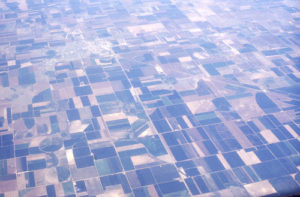
REctangular fields looking much more like Skåne or any agricultural region in Sweden or France, for that matter.
We left our hotel in San Fransisco very early in the morning and left our rental car at whatever the company was this time. Our plane put us down in New Orleans in the late morning — two sleepy people.
We took a long nap in our hotel and when we woke up in the afternoon John called his parents. They suggested we go and have Eggs Benedict at a nice place — on them. Which we did, with much pleasure.
We walked around this enchanting city, especially the French Quarter of course and the incredibly picturesque Bourbon Street, Le Vieux carré. On the second day before taking a plane to Orlando, we walked more around Le Vieux carré and down to the Mississippi. John still had some difficulty walking, but he managed all right, and I have at least seen the Mississippi which I loved to read about in Mark Twain’s ‘Life on the Mississippi’ 6
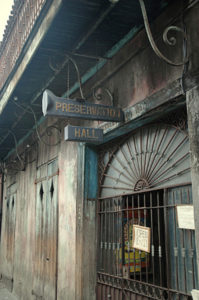
Preservation Hall — The door that leads into the dark room where this jazz band plays its wonderful music. (By Phier at English Wikipedia, CC BY-SA 3.0, )
On our first evening in New Orleans, we went to the Preservation Hall to listen to the genuine traditional New Orleans jazz. All the players were old men who were seemingly very happy to keep up old traditions. Wonderful. Standing room only, just one row of chairs in the front, but we were young and we had a great evening.
Preservation Hall was established in 1961 “to preserve, perpetuate, and protect traditional New Orleans Jazz”. It has become one of the favorite places for tourists, foreign and American, where they go to listen to real old New Orleans jazz, later also referred to as DIxieland jazz.
Long parenthesis: “The word “Dixie” refers to currency issued first by the Citizens State Bank in the French Quarter of New Orleans and then by other banks in Louisiana. These banks issued ten-dollar notes labeled Dix on the reverse side, French for “ten”. The notes were known as “Dixies” by southerners, and the area around New Orleans and the French-speaking parts of Louisiana came to be known as “Dixieland”. Eventually, usage of the term broadened to refer to the Southern states in general.” (Confederate States of America)
John had already been to Preservation Hall in the mid-sixties with his Cajun friend, Clarence from Florida State in Tallahassee, whose mother made the most succulent jambalaya.”7
_________________
This brings back memories from my late teens when we, my classmates and I, got together with our boyfriends on Saturday evenings, very often in my home. We listened to wonderful dixieland jazz and danced. Our favorites were Louis Armstrong and Fats Waller mainly. I had wonderful old 78 vinyls (stenkakor). One of my absolute favorite pieces was ‘Ain’t Misbehaven’ with Fats Waller, and I loved to sing it myself, mimicking Fats, but basically, Louis Armstrong was our favorite
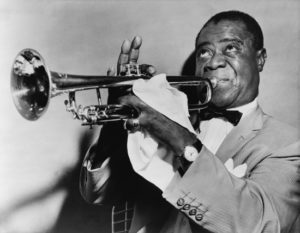
Louis Armstrong and his inimitable trumpet (Wikipedia)
There was Saint Louis blues, West End Blues, Old Rockin’ Chair — Jack Teagarden with his trombone, one of our absolute favorites — Jack Teagarden and Satchmo singing together, alternating as in a dialogue. And there were some other jazz players that we really liked too, Glenn Miller, quite a different kind of band, but I guess we loved his ‘In the Mood‘ our favorite Glenn Miller. However, Louis Armstrong, Satchmo, was after all the hero of our youth.
Oh, that trumpet — we loved it. One of the guys, Lars, nicknamed Lasse, when we played ‘West End Blues’, would time it with his timer-watch when a couple of minutes into the song Satchmo holds out a note for 12 seconds.
My one-time boyfriend, Ingvar, and I went to see the movie ‘New Orleans‘ (Amazing, since his parents wouldn’t usually let him go out during week days, and this was not very likely a Saturday), and I fell in love with ‘Do You Know What It Means To Miss New Orleans‘. I have loved it ever since.
Do you know what it means to miss New Orleans
And miss it each night and day
I know I’m not wrong this feeling’s gettin’ stronger
The longer, I stay away.
Miss them moss covered vines the tall sugar pines
Where mockin’ birds used to sing
And I’d like to see that lazy Mississippi hurryin’ into spring
The moonlight on the bayou a creole tune that fills the air
I dream about magnolias in bloom and I’m wishin’ I was there
Do you know what it means to miss New Orleans
When that’s where you left your heart
And there’s one thing more I miss the one I care for
More than I miss New Orleans
And of course we loved Ella. Ella Fitzgerald with the most wonderful voice ever in the history of jazz I can remember”‘Dream A Little Dream Of Me”, where they sing together and an infinite number of songs — Ella and Satchmo were the very core of Dixieland for us. Oh, the days… and oh, how I loved New Orleans.
__________________
Our second day in New Orleans, we had lunch at ‘The Court of Two Sisters’, also a very special event, and John still remembers that he had oysters, not raw as we eat them in France, but probably fried. He says they were very good.
We loved le Vieux Carré of course, and in those days, 25 years before the disastrous Hurricane Katrina, this quartier was the real thing, not exceedingly spiffed up for tourists, even though tourists in many ways put their imprint on this area, I have now learned that the New Orleans style of architecture with the beautiful wrought-iron work, black or white, was actually not French style architecture, but Spanish — Louisiana west of the Mississippi, including New Orleans, was a Spanish “governorate”, in fact including Cuba. They were part of the Vice-royalty of ‘New Spain’. In 1762 France had given this region to Spain as payment for a debt, and it was given back to France in 1800.
The Louisiana Purchase took place in 1803, most likely because Napoleon needed money for his wars. That meant an addition to the eastern states of a huge area in central North America. Louisiana west of the Mississippi and new Orleans then became part of the United States, and so did the northern parts of New Mexico and Texas. At the end of the Mexican-American War (1846-1848) the rest of the southwest became American states, including California.
On our way down to get a glimpse of the Mississippi, we just happened to pass through beautiful Jackson Square. What luck. There is the Louisiana State Museum, a very interesting building, due to its long colonial history. It is often called the Cabildo (= town council), and it is said to be one of the most historically significant buildings in America, Finished in 1799, the Cabildo served as the seat of government in New Orleans during the Spanish colonial period, when this was part of New Spain. However, since French was the main language in this area, translators were often needed during the governmental sessions at the Cabildo.8
Right next to the Cabildo on Jackson Square is the Saint Louis Cathedral or la Cathédrale Saint-Louis, Roi-de-France — named for Louis IX who became King of France in 1226. The two buildings together give a good glimpse of the French and Spanish history of New Orleans. Also, the square is a beautiful place in itself, surrounded by typical New Orleans style houses. Of course it was made even more of a tourist attraction by the presence of those two historical buildings. In later days it has become overwhelmingly touristy.9
The rich history of New Orleans makes it a diamond among American cities, a very special place. And of course the rich Spanish-influenced architecture makes the city a work of art.
We don’t know how much the city changed due to the disastrous flooding after the 2005 Hurricane Katrina. We do know that huge numbers of the poorest people were driven out of the town and never managed to get back. They were simply not wanted. The people who tried to renovate their partly ruined houses were refused access to them. Entire areas were chained off to the owners of the houses inside, houses that could have been saved. So middle-class or upper-class housing replaced the housing where poor people had lived. It was one of the most heinous internal U.S. crimes of the 21st century. The levees and flood walls that should have protected the city and its surroundings caved in, and this amounted to a criminal lack of maintenance in spite of repeated warnings that reinforcement was urgent. A crime that can never be forgiven or repaired.10
_______________
We arrived in Orlando, but our odyssey was not over yet. we first went to visit my family in and around Tampa, on the west coast of Florida.
This might well have been the very first time we drove to Tampa when in Orlando, but it was followed by a long row of visits to my family. It was wonderful to see them all
It also turned out that our tour was still not over, since Bert and Margaret wanted us to come with them to their Linville, North Carolina, summer home, where we had never been. It got to be a very long U.S. vacation that year.
We got to know the beautiful and very southern looking city of Savannah, Georgia on the way up, interesting to me especially, since I had never been to Georgia before.
This is the real South which I know very little about firsthand. What I know about it comes from reading about it, the Civil War history and all.
Frank, an old friend of John’s from Duke University, who went on to become a judge in Washington D.C. came down to spend a couple of days with us. He also became my friend of course, and he has visited us here in Genas a couple of times.
Above is the only photo, be it ever so tiny, that we have of dear Frank, even though he came to visit us both in Paris and here in Genas. We went for a very scenic walk with Frank, and John took some pictures, one of Frank and me with the lower Linville Falls in the background. The North Carolina countryside is beautiful and quite mountainous.
One memory that sticks in my mind was how Bert, when he realized that I had never seen cotton balls on growing cotton plants, walked out into a field on our way up from Orlando and picked the tip of a branch for me. I put the cotton ball in a box and kept it for many years. It may still be around somewhere.
Continued: Chapter 33 (Part 1) – We move to Lyon
- Gnadenhutten erected a monument to the martyrs of the March 8, 1782 massacre during the centennial of its founding, and in 1963 established a museum interpreting it and other aspects of the town’s history ↩
- Wikipedia: “The national park lies above an underground evaporite layer or salt bed, which is the main cause of the formation of the arches, spires, balanced rocks, sandstone fins, and eroded monoliths in the area. This salt bed is thousands of feet thick in places, and was deposited in the Paradox Basin of the Colorado Plateau some 300 million years ago when a sea flowed into the region and eventually evaporated. Over millions of years, the salt bed was covered with debris eroded from the Uncompahgre Uplift to the northeast. During the Early Jurassic (about 210 Ma) desert conditions prevailed in the region and the vast Navajo Sandstone was deposited.” ↩
- Spruce Tree House is the third largest and best preserved cliff dwelling in the park. Normally open to the public, in August 2015, a rock fall at Spruce Tree House cliff dwelling prompted park officials to close the site for visitor safety until an analysis and hazard assessment could be conducted. After that initial evaluation was completed in September 2015, it was decided that the entire site should be closed to the public in October 2015. ↩
- Chicago November 2006 ↩
- San Francisco’s Board of Supervisors today approved a sweeping new zoning law designed to limit the construction of skyscrapers and reduce by half the number of office jobs projected for its congested downtown over the next 15 years. BUILDINGS CURBED BY SAN FRANCISCO — 1985 ↩
- Life on the Mississippi (1883) is a memoir by Mark Twain of his days as a steamboat pilot on the Mississippi River before the American Civil War, and also a travel book, recounting his trip along the Mississippi River from St. Louis to New Orleans many years after the War. ↩
- Preservation Hall — Operating as a music venue, a touring band (the Preservation Hall Jazz Band), a record label, and a non-profit organization, Preservation Hall continues their mission today as a cornerstone of New Orleans music and culture. Situated in the heart of the French Quarter at 726 St. Peter Street, Preservation Hall presents intimate, acoustic New Orleans jazz concerts nightly featuring some of New Orleans’ finest performers, showcasing a musical legacy dating back to the origins of jazz itself. ↩
- The Cabildo is one of the most historically significant buildings in America. Built between 1795 and 1799 to replace a structure that burned in the 1794 fire, the Cabildo served as the seat of government in New Orleans during the Spanish colonial period. ↩
- The Cathedral-Basilica of Saint Louis, King of France, also called St. Louis Cathedral (French: Cathédrale Saint-Louis, Roi-de-France, is the seat of the Roman Catholic Archdiocese of New Orleans and is the oldest cathedral in what would become the United States. The first church on the site was built in 1718; the third, built in 1789, was raised to cathedral rank in 1793. The cathedral was expanded and largely rebuilt in 1850, with little of the 1789 structure remaining. ↩
- 2005 levee failures in Greater New Orleans ↩


